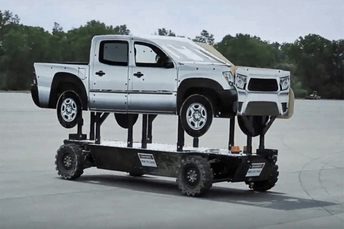Reading Time: 2 minutes

One example on show at this year’s I/ITSEC is a reactive vehicle platform and target system from Michigan-based Pratt Miller, which is currently wrapping up Phase 2 development for PEO STRI as part of a small business innovative research (SBIR)-funded project.
To aid with realism, the battery-powered four-wheeled vehicle can be mounted with an array of two dimensional and three dimensional targetry to mimic a range of threats from armour to pick-up trucks.
Known as the Trackless Moving Target-Vehicle (TMT-V), the project is likely to move into Phase 3 by the end of the year. Pratt Miller told Shephard that they were still awaiting the Phase 3 RFP, but the scope will likely be focused on the commercialisation of the platform over a 22-month period.
‘During that time we are going to focus on the reliability of the platform, the serviceability and the user interface,’ said Jim Fontaine, Pratt Miller’s account manager for ground robotics. ‘The target is for TRL 8, maybe 9 if we can stretch the funding enough to get there.’
By incorporating reactive behaviours and autonomy, the vehicles makes range training less predictable and enhances the training experience. Traditionally, moving target practice relies on rail-based tracked systems that do not provide a realistic representation of enemy movement.
Pratt Miller currently works with another Michigan-based company, Quantum Signal, to develop the autonomy, behaviours and interface elements.
During Phase 3, the company hopes it can seek early adopters that are interested in ‘putting the platform through its paces’, which could include the military or even independent companies that provide range services.
‘We would like to see this being utilised on ranges to get as much information as possible for final production,’ said Fontaine. A programme of record and low-rate initial production (LRIP) could follow after the conclusion of Phase 3, although this is subject to army funding and requirements.
The vehicle – which utilises commercial off-the-shelf technology for major subsystems – has already been demonstrated at TRL 7 during trials at Fort Benning, Georgia. It also utilises an open-architecture system around both FASIT and TRACR requirements, meaning various targetry equipment can be integrated from different suppliers.
At I/ITSEC 2016, the TMT-V has a Thiessen mechanism that lifts a target representing a pick-up truck. Fontaine told Shephard that an infantry version has also been developed, called the Trackless Moving Target-Infantry (TMT-I), which is being funded by PEO STRI through a 24-month Rapid Innovation Fund (RIF).
One of the aims is to ensure the TMT-V and TMT-I have a similar maturity level and can utilise the same toolsets, including mission planning tools, meaning that range staff can begin replicating complex scenarios involving infantry targets and vehicle targets.
‘It needs to act more like a person would, so we are working on an advanced sensor package for that, so it can perceive more and react accordingly,’ said Fontaine.
Article by: by Grant Turnbull in Orlando – Shephard Media
Reach out to us to see how we can help solve your toughest design, engineering and production problems and bring your innovative vision to reality.

